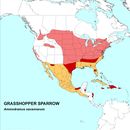en
names in breadcrumbs


A small (4 ½ inches) sparrow named for its insect-like song, the Grasshopper Sparrow is easy to overlook. Mostly buff-brown streaked with brown above and cream below, this sparrow may be identified from its large head, small body, and pale eye-stripes. Males and females are similar to one another in all seasons, while the juvenile has a streaked breast. The Grasshopper Sparrow breeds across a large portion of the eastern United States and the Great Plains from the Canada border well into the Deep South. There are also isolated breeding areas in the mountain west and along the coast of California. Despite its wide distribution, however, the Grasshopper Sparrow is an uncommon breeder throughout most of its breeding range due to specific habitat requirements. Grasshopper Sparrows migrate south for the winter, where they may be found along the Gulf coast, the coastal southeast, and along the U.S. -Mexico border. The Grasshopper Sparrow inhabits grassland habitats in its breeding and winter ranges. This species prefers grasslands that are drier and more open, with less ground-covering grass litter, than those inhabited by Henslow’s Sparrow (Ammodramus henslowii). In summer, Grasshopper Sparrows eat insects (coincidentally, grasshoppers make up a significant portion of their diet), while in winter, they primarily eat seeds. Grasshopper Sparrows forage on the ground. Like many grassland-dwelling bird species, the Grasshopper Sparrow is best identified by ear, specifically by listening for its insect-like song. Due to its feeding habits and cryptic coloration, Grasshopper Sparrows are difficult to see while at rest, and may be most easily seen while on short flights above the grass.